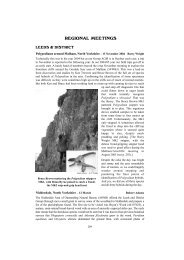Full Contents as pdf File - Natural History Museum
Full Contents as pdf File - Natural History Museum
Full Contents as pdf File - Natural History Museum
Create successful ePaper yourself
Turn your PDF publications into a flip-book with our unique Google optimized e-Paper software.
eported that, with the notable exception of Cyathea contaminans, few tree-ferns occupy<br />
major disturbance sites.<br />
Al<strong>as</strong>tair Wardlaw and Martin Rickard chaired a discussion on the conservation of treeferns.<br />
Clive Jermy, unavoidably absent, had prepared a useful handout with some key points<br />
for consideration.<br />
Much discussion took place on whether the bureaucracy surrounding CITES (Convention<br />
on International Trade in Endangered Species) and other legislation designed to protect<br />
either the ferns themselves or the rights of the country of origin w<strong>as</strong> in fact hampering the<br />
process of conservation. It is difficult to obtain material of different species of tree-ferns for<br />
ex situ conservation. Chris Page spoke about one Darwin Initiative Project that had helped<br />
in the conservation of the ferns of Mauritius. Flora & Fauna International’s indigenous<br />
propagation projects were also mentioned; these aim to provide a viable replacement for<br />
trade in indigenous plants.<br />
Barry Thom<strong>as</strong> then gave us an illustrated talk on the f<strong>as</strong>cinating subject of ‘Fossil treeferns’.<br />
He showed us how the earliest land plants such <strong>as</strong> Cooksonia evolved within a short<br />
space of time to give larger descendants of which some started to grow upwards to exploit<br />
the advantages that size gave. The problems of recognising tree-ferns in the fossil record<br />
were outlined and the advantages of finding anatomically preserved stems stressed. The<br />
range of fossil remains of tree-ferns w<strong>as</strong> reviewed from the Palaeozoic to the present day,<br />
including much new work published in the l<strong>as</strong>t few years. Two types of stem anatomy are<br />
known to have evolved several times in different families of ferns. The commoner type<br />
incre<strong>as</strong>es in size by dividing its v<strong>as</strong>cular strand <strong>as</strong> is found in the Marrattialeans (known<br />
from the Carboniferous onwards), the Osmundaceae (that were largest in the Permian), the<br />
Cyatheaceae and the Dicksoniaceae. The other stem type (such <strong>as</strong> in some new<br />
Carboniferous petrified stems and in the Mesozoic Tempskya, although none are known<br />
today) w<strong>as</strong> actually a series of interwoven stems and, like the other type, covered in a dense,<br />
supporting root mantle. Although rather different, both forms were strong and flexible.<br />
Visually, though, the two stem types were rather different. The commoner tree-ferns, that<br />
we all know, have a crown of fronds, but the others grew leaves along the lengths of their<br />
interwoven stems. We clearly do not know enough about tree-fern evolution yet, but Barry<br />
w<strong>as</strong> optimistic that new discoveries would continue to incre<strong>as</strong>e our knowledge of it.<br />
In his talk ‘Tree-ferns growing outside in Britain’, Al<strong>as</strong>tair Wardlaw reported that tree-ferns<br />
have been grown in Britain since at le<strong>as</strong>t 1786. Only one, however, according to the The New<br />
Atl<strong>as</strong> of the British and Irish Flora (2002) h<strong>as</strong> become established in the wild, and that is<br />
Dicksonia antarctica. Although the limit of latitude in which tree-ferns grow in the southern<br />
hemisphere is equivalent to the middle of France, in gardening we do not have the same<br />
constraints since we are not hostage to the prothallus stage and can even ‘avoid’ the early years<br />
of the sporeling’s growth. As early <strong>as</strong> 1872, Arthur Smee w<strong>as</strong> describing his cultivation in both<br />
pots and in open ground in London and this w<strong>as</strong> at the time immediately before the Thames<br />
froze over in many winters. Al<strong>as</strong>tair went on to describe a number of experiments that he had<br />
carried out to protect his plants in the Gl<strong>as</strong>gow region. He had also me<strong>as</strong>ured the temperature<br />
inside and outside his various coverings <strong>as</strong> well <strong>as</strong> in the crowns of the plants and interpreted<br />
these temperatures in the light of any damage to the plants the following year.<br />
A general discussion then ensued on the day’s proceedings, when mention w<strong>as</strong> made about the<br />
nature of hardiness of the southern-most colonies of the commonly grown tree-ferns and why<br />
it may not be possible to replicate these conditions in a typical northern hemisphere garden.<br />
Our hosts for the day thanked our distinguished guests and were in turn thanked for<br />
organising such an informative and interesting day. About 65 people were counted at one<br />
point of the day, which is quite a large fraction of the inland membership.<br />
120

















